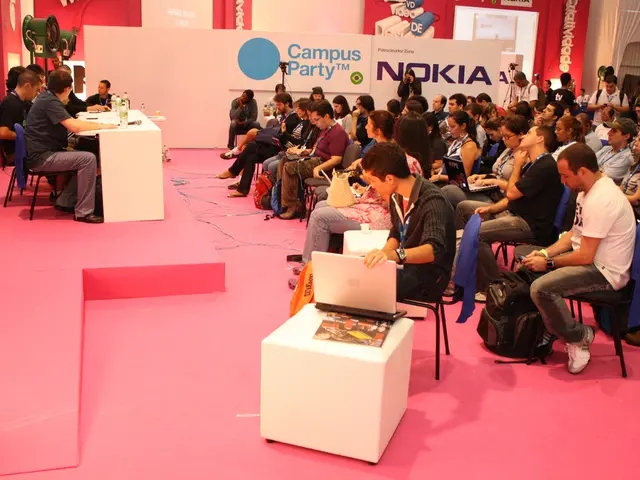Model for Brand Connection and Recognition
In the realm of marketing and branding, the Brand Resonance Model (BRM) stands out as a powerful framework for creating deep emotional connections with consumers. This model, when implemented effectively, can lead to enhanced brand equity, increased customer loyalty, and long-term relationships.
What is the Brand Resonance Model?
The Brand Resonance Model is a strategic approach that guides businesses in cultivating brand loyalty, advocacy, and resonance among their customers. It involves building brand salience, performance, and imagery, as well as cultivating brand judgments and feelings, ultimately achieving deep brand resonance.
Real-world Examples of the Brand Resonance Model
Several global companies have successfully implemented the BRM, creating deep emotional connections and loyalty with their consumers.
- Nestlé’s KitKat in Japan: By tapping into local culture and offering region-specific flavours, Nestlé has leveraged the phonetic similarity of KitKat to the Japanese phrase kitto katsu ("surely win"). This connection to local rituals of encouragement and gift-giving has strengthened the brand's resonance in Japan.
- Airbnb’s “Host Stories” Campaign: By making hosts the heroes of the narrative, Airbnb fosters emotional engagement and community identification. This approach aligns with the brand resonance idea of customers developing a strong bond based on shared values and personal meaning.
- Volvo’s “A Million More” Campaign: Volvo blends product innovation with personal safety stories from real individuals saved by its cars. This merging of functional associations (safety, engineering excellence) with emotional impact promotes intense brand loyalty.
- Michael Kors “The Walk” Influencer Campaign: By integrating street style influencers and encouraging user-generated content, Michael Kors enhances brand salience and community involvement.
- IKEA’s Functional Billboard in Sweden: IKEA creatively connected its brand message of resourcefulness and comfort by reflecting sunlight onto cold outdoor seating areas, providing warmth. This physical brand experience builds a memorable and emotional association.
The Benefits of Adopting the BRM
Adopting the BRM offers numerous benefits, including enhanced brand equity, increased customer loyalty, brand advocacy and word-of-mouth, competitive advantage, and long-term relationships with customers.
Other Marketing Strategies and Concepts
In addition to the Brand Resonance Model, there are numerous other strategies and concepts that businesses can employ to achieve their marketing objectives. These include:
- Inbound Marketing: Attracting customers through content marketing, search engine optimization, and social media marketing.
- Go-To-Market Strategy: A business strategy outlining how a company will penetrate a target market and achieve competitive advantage.
- Push vs. Pull Marketing: The distinction between marketing tactics that push products onto customers versus those that pull customers towards a product.
- Microtargeting: Using data analysis to identify and target specific audience segments with personalized marketing messages.
- Multi-Channel Marketing: Using multiple communication channels to reach customers and deliver a consistent brand message.
- Sustainable Marketing: Creating products and services that are environmentally friendly and socially responsible.
- Greenwashing: A deceptive marketing practice where a company claims to be environmentally friendly to mislead consumers.
- Neuromarketing: Using insights from neuroscience to influence consumer behavior and decision-making.
- Marketing Myopia: A short-term focus on current sales rather than long-term growth and customer needs.
- Guerrilla Marketing: Using unconventional, low-cost marketing tactics to generate buzz and reach a large audience.
- Growth Marketing: Strategies designed to accelerate a company's growth through customer acquisition and retention.
- Hunger Marketing: Creating a sense of urgency or scarcity to drive sales and customer engagement.
- Newsjacking: Leveraging current events to gain attention and promote a product or service.
- Brand Response: Consumers' cognitive, affective, and behavioral reactions to the brand, including measures of brand awareness, brand image, brand attitudes, purchase intentions, and loyalty levels.
- Remarketing: Targeting customers who have previously interacted with a brand to encourage them to return and make a purchase.
- Sensory Marketing: Appealing to customers' senses to create an emotional connection to a product or brand.
- Word-of-Mouth Marketing: Leveraging positive customer experiences to generate buzz and promote a product or service.
- Niche Marketing: Serving a specific market segment with specialized products or services.
- Marketing Mix: The combination of product, price, promotion, and place components that a company uses to deliver a product or service to its customers.
- Services Marketing: The delivery of intangible goods or services to customers.
- Relationship Marketing: Building long-term relationships with customers to increase loyalty and repeat business.
- Brand Meaning: The unique value proposition and positioning that a brand communicates to its target audience, encompassing functional, emotional, and symbolic benefits.
- Brand Identity: Tangible and intangible attributes that distinguish a brand from its competitors, including name, logo, slogan, colors, symbols, brand associations, personality traits, and values.
- Multi-Level Marketing: A business model where participants earn commissions by recruiting new participants.
- Integrated Marketing: Combining various marketing tactics to deliver a consistent brand message and achieve marketing objectives.
- Integrated Communication: The coordination of all communication efforts across different channels to deliver a consistent brand message.
- 360 Marketing: A holistic approach to marketing that involves coordinating all marketing efforts across different channels to deliver a consistent brand message.
- Grassroots Marketing: Promoting a product or service through community-based efforts and word-of-mouth.
- Real-Time Marketing: Responding to current events and trends to create timely and relevant marketing content.
- Net Promoter Score: A measure of customer loyalty by asking customers how likely they are to recommend a company or product to others.
- Reverse Marketing: Targeting customers who have already shown an interest in a product or service.
- Types of Business Models, Business Strategy, Marketing Strategy, Platform Business Models, Network Effects, Gross Margin: Related topics in business and marketing.
- Meme Marketing: Leveraging viral internet content, such as images or videos, to promote a product or service.
Each of these strategies and concepts can play a crucial role in a company's marketing efforts, depending on its specific goals and target audience. By understanding and applying these strategies effectively, businesses can create powerful and impactful marketing campaigns that resonate with their customers and drive growth.
- The Brand Resonance Model (BRM) is a strategic approach that guides businesses in creating deep emotional connections with consumers, leading to enhanced brand equity, increased customer loyalty, and long-term relationships.
- Nestlé’s KitKat in Japan utilizes the BRM by tapping into local culture, offering region-specific flavors, and leveraging the phonetic similarity to the Japanese phrase kitto katsu, fostering emotional connections and loyalty.
- Airbnb’s “Host Stories” Campaign aligns with the BRM idea of customers developing a strong bond based on shared values and personal meaning, fostering emotional engagement and community identification.
- Volvo’s “A Million More” Campaign promotes intense brand loyalty by blending product innovation with personal safety stories, merging functional and emotional associations.
- In addition to the BRM, other marketing strategies businesses can employ include Inbound Marketing, Go-To-Market Strategy, and Multi-Channel Marketing, among others, to achieve their objectives.
- By understanding and applying these strategies effectively, businesses can create marketing campaigns that resonate with their customers and drive growth, such as Sustainable Marketing, Brand Response, and Relationship Marketing.
- Competitors can also employ strategies like Guerrilla Marketing, Newsjacking, and Meme Marketing to generate buzz and promote their products or services.
- Monitoring metrics like Net Promoter Score, word-of-mouth, and brand awareness can help businesses evaluate the success of their marketing strategies and make informed decisions for future growth through innovation, scale, and finance management.




